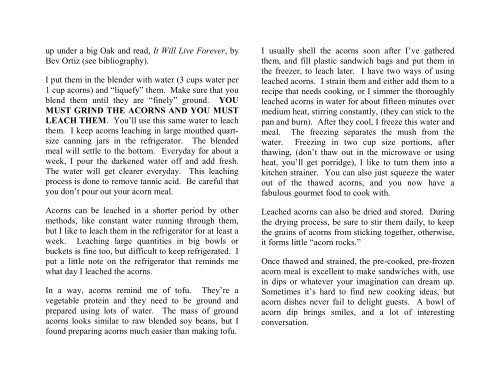You also want an ePaper? Increase the reach of your titles
YUMPU automatically turns print PDFs into web optimized ePapers that Google loves.
up under a big Oak and read, It Will Live Forever, <strong>by</strong><br />
Bev Ortiz (see bibliography).<br />
I put them in the blender with water (3 cups water per<br />
1 cup acorns) and “liquefy” them. Make sure that you<br />
blend them until they are “finely” ground. YOU<br />
MUST GRIND THE <strong>ACORNS</strong> <strong>AND</strong> YOU MUST<br />
LEACH THEM. You’ll use this same water to leach<br />
them. I keep acorns leaching in large mouthed quartsize<br />
canning jars in the refrigerator. The blended<br />
meal will settle to the bottom. Everyday for about a<br />
week, I pour the darkened water off and add fresh.<br />
The water will get clearer everyday. This leaching<br />
process is done to remove tannic acid. Be careful that<br />
you don’t pour out your acorn meal.<br />
Acorns can be leached in a shorter period <strong>by</strong> other<br />
methods, like constant water running through them,<br />
but I like to leach them in the refrigerator for at least a<br />
week. Leaching large quantities in big bowls or<br />
buckets is fine too, but difficult to keep refrigerated. I<br />
put a little note on the refrigerator that reminds me<br />
what day I leached the acorns.<br />
In a way, acorns remind me of tofu. They’re a<br />
vegetable protein and they need to be ground and<br />
prepared using lots of water. The mass of ground<br />
acorns looks similar to raw blended soy beans, but I<br />
found preparing acorns much easier than making tofu.<br />
I usually shell the acorns soon after I’ve gathered<br />
them, and fill plastic sandwich bags and put them in<br />
the freezer, to leach later. I have two ways of using<br />
leached acorns. I strain them and either add them to a<br />
recipe that needs cooking, or I simmer the thoroughly<br />
leached acorns in water for about fifteen minutes over<br />
medium heat, stirring constantly, (they can stick to the<br />
pan and burn). After they cool, I freeze this water and<br />
meal. The freezing separates the mush from the<br />
water. Freezing in two cup size portions, after<br />
thawing, (don’t thaw out in the microwave or using<br />
heat, you’ll get porridge), I like to turn them into a<br />
kitchen strainer. You can also just squeeze the water<br />
out of the thawed acorns, and you now have a<br />
fabulous gourmet food to cook with.<br />
Leached acorns can also be dried and stored. During<br />
the drying process, be sure to stir them daily, to keep<br />
the grains of acorns from sticking together, otherwise,<br />
it forms little “acorn rocks.”<br />
Once thawed and strained, the pre-cooked, pre-frozen<br />
acorn meal is excellent to make sandwiches with, use<br />
in dips or whatever your imagination can dream up.<br />
Sometimes it’s hard to find new cooking ideas, but<br />
acorn dishes never fail to delight guests. A bowl of<br />
acorn dip brings smiles, and a lot of interesting<br />
conversation.


